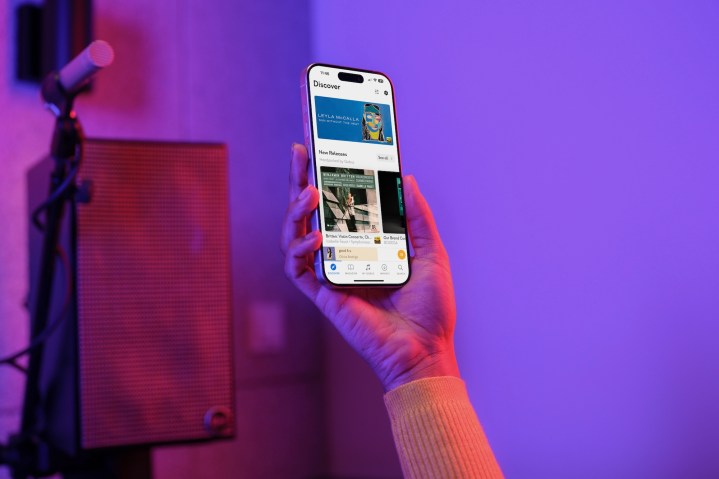
Are you a music lover who craves the highest-quality sound possible, but can’t quite afford the hefty price tag that comes with a top-of-the-line audio setup like turntables, integrated amplifiers, and hi-fi speakers? Fear not, my friend, for there is a solution — Qobuz, the ultra-high-quality music streaming platform that will have you listening and singing to the tunes of your favorite artists in no time.
While some audiophiles may argue that physical media is the only way to achieve true sound quality, the convenience and affordability of Qobuz is hard be beat. So sit back, relax, and let us guide you through everything you need to know about this music streaming service. Just be sure to keep it on the down-low from your vinyl-collecting pals — we wouldn’t want to start a music war.
What is Qobuz?
Qobuz is a music-streaming platform with access to over 100 million songs, all of which are available in the hi-res FLAC (Free Lossless Audio Codec) format. As far as quality goes, it’s tough to beat the kind of clarity, dynamic range, and definition you’ll hear on a Qobuz track, with the catalog being available from CD-quality (16-bit at 44.1kHz) up to 24-bit at 192kHz.
Desktop and mobile apps are available, but you can also use Qobuz’s browser-based web player. The platform offers two subscription tiers (covered below), algorithmic recommendations, album liner notes, and a host of other features.
How much is Qobuz?
Qobuz offers two main subscriptions: Studio and Sublime. The former offers a Solo tier, aDuo tier for two people, and a Family tier for up to six people in the same household. Each tier will net you nearly all the benefits one can get from the platform, including access to the entire library, offline downloads, and 24-bit 192kHz FLAC songs and albums (when available).
Solo: $13 per month ($130 per year)
Duo: $18 per month ($180 per year)
Family: $22 per month ($216 per year)
Sublime comes with all the same base perks as Studio, plus up to 60% off hi-res download purchases, but the tiers must be purchased as a single-payment yearly subscription, which is a little confusing on the website, so be forewarned. Sublime also includes a Solo tier, a Duo tier for two people, and a Family tier that gives you up to six accounts in the same house.
Solo: $180 per year (equal to $15 per month)
Duo; $270 per year (equal to $22.50 per month)
Family: $350 per year (equal to $29.16 per month)
How do you sign up for Qobuz?
You can download the Qobuz mobile app for iOS and Android devices. There’s also a desktop app for Windows and macOS computers and a browser-based web player.
Once you’ve entered your email and password, you’ll be taken to a personalization screen where you’ll be asked if you’d like to receive news and special offers from Qobuz and its affiliates. This panel also lets you pick a few of your favorite music genres to help Qobuz curate content for you. After you’ve completed creating your account, you’ll be taken to a Qobuz launch screen, where you’ll be able to download whatever desktop app your machine supports, or launch the web player.
Similar to Deezer, Qobuz (in partnership with Soundiiz) also offers a playlist transfer feature, which you should see a banner for at the bottom of the screen. You can also find the tool on the Soundiiz website.
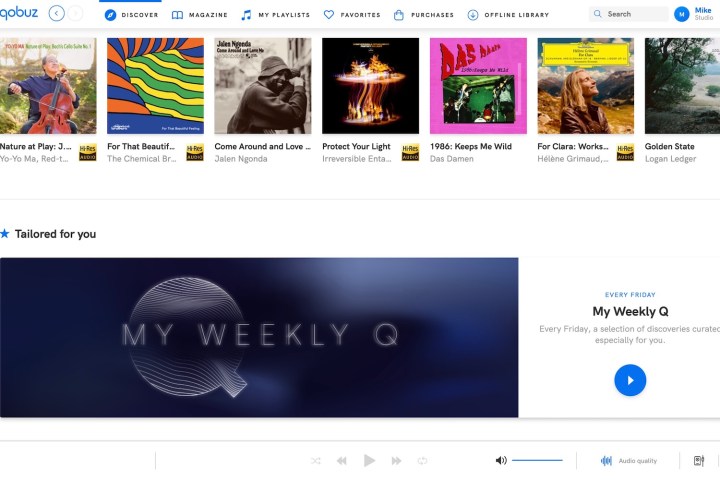
How do you use Qobuz?
Qobuz’s desktop app offers an exceptional user interface. After launching, you’ll be on the Discover screen, which is broken up into a few sections. Under New Releases you’ll be able to see all the platform’s newest albums, with hi-res Studio offerings labeled accordingly (there’ll be a hi-res logo placed next to the entry). Scroll down a bit to find the Tailored For You player. Every Friday, Qobuz will compile a new list of tracks based on your musical tastes and listening history.
Scroll down a bit further to find The Qobuz Playlists, a collection of platform playlists that you can filter by format, release date, artists, and a few other categories. At the bottom of the Discover panel is a section called The Taste of Qobuz, which pairs handpicked Qobuz artists and albums with incredible synopses of the chosen material.
You’ll see five other tabs at the top of the app. From left to right (after Discover), these are Magazine, My Playlists, Favorites, Purchases, and Offline Library. Magazine is an amazing hub for the written word, featuring news, interviews, op-eds, retrospectives, and hi-fi listening tutorials and guides.
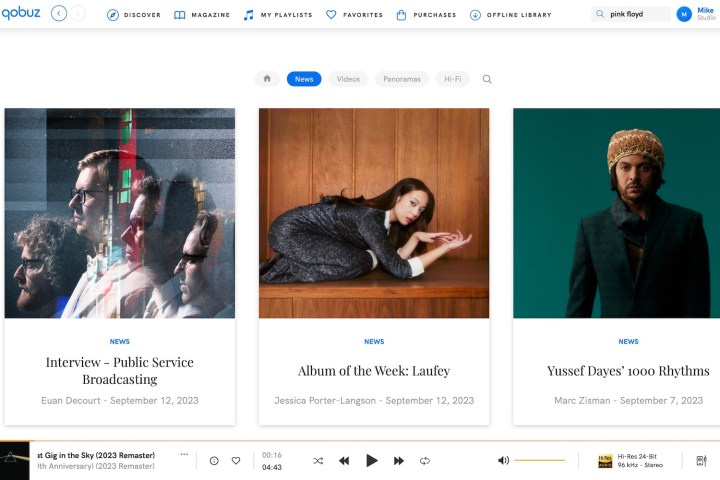
My Playlists is where all of your liked playlists are stored, as well as where you’ll go to create your very own. You can also build collaborative playlists that you can share with other Qobuz users. Favorites is where all of your favorited tracks and artists are stored, and Purchases is where you’ll be able to find any album you’ve downloaded. Then there’s Offline Library, which is where any track, album, or playlist you’ve imported for internet-free access lives. You can also search for songs, artists, albums, and playlists using the search field next to Offline Library.
When you’re listening to a song, playback controls are located at the bottom of the app. You’ll also be able to choose what audio quality the track or album streams at (capped at hi-res 24-bit/up to 192kHz where applicable). A speaker icon is what you’ll click to manage Qobuz’s audio output options. The last button on the playback ribbon is labeled Play Queue. Click to see what track you’re currently playing, what tracks Qobuz has lined up for you next, and what you’ve listened to in the past.
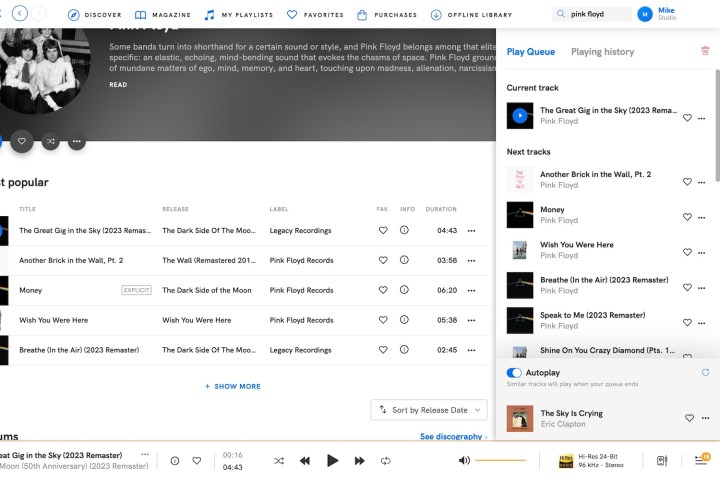
Searching for a particular artist is particularly impressive because Qobuz builds out a full-fledged dashboard for the group. For example, Metallica’s Qobuz page is filled with the band’s most popular tracks, all albums listed chronologically, links to Magazine pieces, suggestions for similar artists, and more.
Overall, navigation is smooth and simple, and all artists and albums are laid out in a very organized manner. The same goes for the iOS app. Its five main tabs are listed at the bottom of the Home Screen, which are Discover, Magazine, My Qobuz (a combination of Favorites and My Playlists), Imports (a different name for Offline Library), and Search.
Swiping from one screen to the next is quick and responsive, as is selecting songs and artists, and running searches for content.
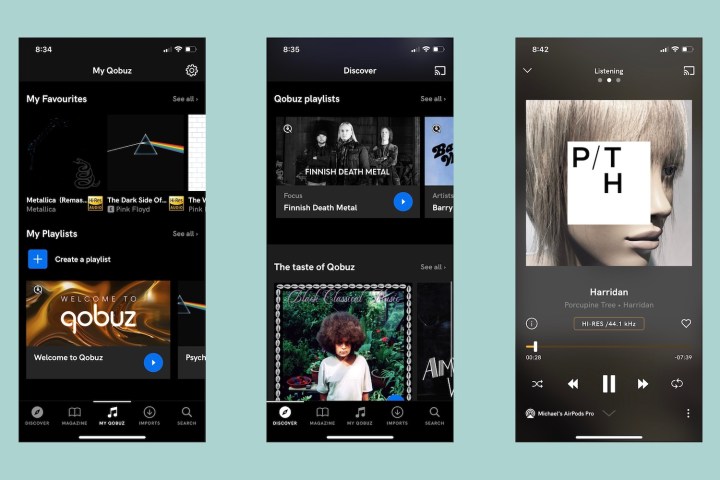
We also tested Qobuz’s browser-based player and dashboard, which is nearly identical to the desktop app in appearance and navigation but runs just a tad bit slower.
What is Qobuz Club?

One feature that has been added to Qobuz somewhat recently is the Qobuz Club. Currently only accessible through the Qobuz website, the Qobuz Club is where Qobuz users can connect with other music enthusiasts and learn more about high-quality music listening. You can also use the forum to connect with Qobuz about issues or concerns.
As of March 2024, you can subscribe to Qobuz Club VIP. A membership, which costs $64 yearly, includes additional benefits like exclusive discounts and priority customer service.
How do you buy music with Qobuz?

One of the best parts of Qobuz is that you can purchase entire albums in hi-res Audio without a subscription. Of course, this service is available to Studio and Sublime members, too. You can also purchase tunes through the desktop app or the Qobuz site.
To do so, search for the song or album you want to download. Once found, tap the three dots icon next to it and click Buy. You’ll then be asked if you’d like to purchase the album in CD quality or whatever the best hi-res format is. As mentioned in our pricing section, you’ll notice that hi-res downloads are significantly cheaper with the Sublime subscription. Once your purchase is complete, the tracks or album will be downloaded to your PC.
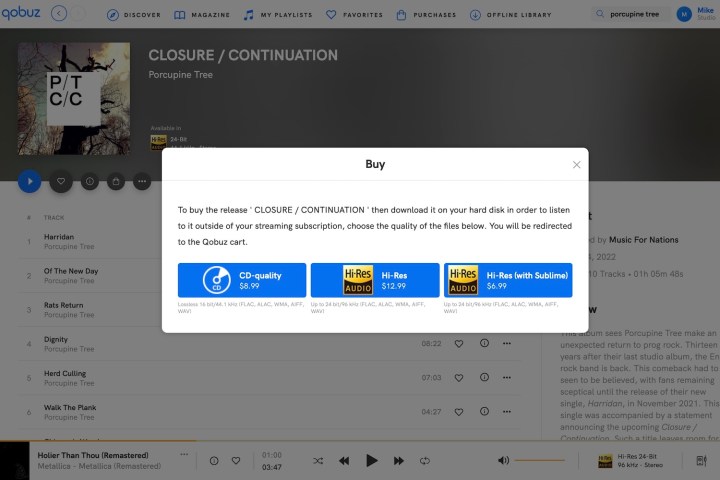
What is Qobuz’s audio quality like?
For a music platform that’s wholly dedicated to audiophile listening, Qobuz truly lives up to its hi-fi promise. All of the platform’s 100 million-plus songs are available in lossless FLAC, with some of it offered up in CD-quality (16-bit at 44.1kHz) and much of it, according to Qobuz, at up to 24-bit 192kHz hi-res quality. Keep in mind, though, that to experience this audio quality you will need to use headphones or a speaker system and likely a digital-to-analog converter (DAC) that can support it. We have a great explainer on all you need that you should check out.
Depending on the song and artist, the hi-res libraries of both Tidal and Amazon Music Unlimited may give Qobuz a little more competition. We’re not playing favorites, but if you’re running your tunes through an external DAC that feeds out to hi-fi speakers, Qobuz is one of the best platform choices you can make.
What devices support Qobuz?
In addition to desktop and mobile apps, Qobuz is supported by a mighty pantheon of hi-fi brands, including Cambridge Audio, Sonos, Bluesound, JBL, LG, KEF, Klipsch, McIntosh, NAD, and many more.
You’ll also be able to download the Qobuz app on Samsung Smart TVs and can use the platform through CarPlay and Android Auto for a bit of vehicular listening.
What is Qobuz missing?
Qobuz is an incredible streamer for audio enthusiasts and layman listeners alike, but it’s missing a few elements that competitive streamers are lauded for. The Dolby Atmos format is a premium codec that provides spatial audio, making it sound like you’re in the middle of the music. Unfortunately, Qobuz does not support this format, which puts it at a disadvantage compared to other music streaming platforms like Tidal, Apple Music, and Amazon Music Unlimited , which do support Dolby Atmos.
Apart from that, Qobuz also lacks video content and podcasts, which are available on many other streaming platforms. It also has limited social features, which means that it may not be the best choice if you’re interested in discovering what your friends are listening to. In contrast, Spotify has a robust social feature that allows you to share your playlists and see what your friends are listening to.
Lastly, Qobuz does not offer native support for smart home devices such as Alexa, Google Assistant, or Apple HomeKit. This means that you cannot use voice commands to control your music playback on Qobuz. However, you can still play Qobuz on your smart speakers or home theater system using Bluetooth or AirPlay.



